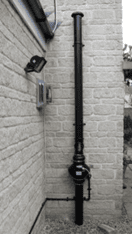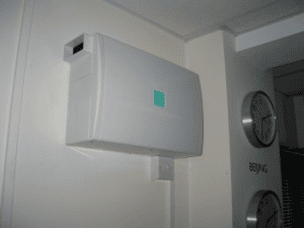Radon – How to Test and Mitigate.

In this article, Robert Owen from propertECO explains how radon testing is carried out and how high levels of radon can be mitigated. This information may be useful for clients if a property is found to be in an area where radon levels may be higher than average.
What is radon and what is the risk?
Radon is a very ‘short lived’ element produced by the radioactive decay of radium-226, which is found in uranium ores associated with phosphate rock, shales, igneous and metamorphic rocks such as granite. It is also associated with rocks such as limestone.
Radon is a radioactive gas that you cannot see, smell or taste. Although more normally associated with areas built on rock, such as Cornwall, radon is present at low levels in the soil and probably accounts for the most common background radiation we are exposed to. It can accumulate in buildings and, when it builds up, it can be a serious risk to long-term health.
When we inhale radon, the radioactive elements continue to emit radiation inside our lungs which our lung tissue absorbs, causing localised damage. This damage can progress and result in lung cancer.
Whilst we are all aware that smoking is the leading cause of lung cancer – did you know that according to the National Cancer Institute, Radon is the second leading cause of lung cancer worldwide?[1]
Given the risk, Public Health England has provided an online, interactive map which shows where high radon levels are more likely to occur across the UK, but as levels can vary from one building to the next, the most reliable way to find out if a property has high radon levels is to carry out tests.
Radon detectors or radon monitors can take accurate measurements of radon in an individual home, which is a reliable test for identifying high levels of this unwanted natural gas. This means action can be taken to reduce the levels, and therefore reduce the health risk associated with it.
Types of radon testing
Testing for radon can be carried out by using passive tests – where no electrical power is required – or tests using digital devices which monitor radon levels over a longer period.
Passive radon detectors are the more common choice and options include a 10-day screening test or a 3-month test.
10-day screening tests are ideal for those who are looking to sell or purchase a property and require quick results to determine the levels of radon in a property. However, 3-month tests consider fluctuations in indoor radon concentrations and therefore provide more accurate results.
It is recommended that at least two radon detectors are used when testing as this allows for readings to be taken in more than one main living area, such as the living room and bedroom. The detectors are then sent to a laboratory where they are analysed, and the results are sent back to the customer.
Digital radon detectors are another form of testing which provide on-site readings of radon levels in the property. These are predominantly used for constant monitoring of radon levels in a property and this method is generally a more expensive, but thorough way of measuring radon levels.
What is considered a high level?
Radon is present everywhere, but exposure to higher levels results in a higher health risk. Radon levels are measured in Becquerels per cubic metre of air (Bq/m³). If the radon levels are below 100 Bq/m³ then it is not considered necessary to conduct any mitigation. However, if the levels are in excess of 100 Bq/m³ then mitigation work will be required to reduce levels of radon.
Properties with basements or cellars are particularly susceptible to higher levels of radon gas as they are underground and therefore closer to the source of radon.
Types of radon mitigation
After the testing period is complete, if the results found a high level of radon, mitigation can be carried out to reduce the radon levels in the property. The two main types of mitigation techniques that can be used are:
• a radon sump
• positive pressure systems
The most preferred method for remediation is using a radon sump. This is where a void is created beneath the property, which then becomes the lowest point of pressure. Any radon present in the soil will be drawn towards the void by suction, created by an electric fan. The gas can then be safely vented away with the assistance of a powered fan, through an exhaust pipe. The exhaust pipe will then vent the harmful radon gas away from the property. It’s important that the exhaust pipe is not located near any doors or windows to ensure that the radon gas is not vented back into the building.

Figure 1 – radon sump installation

Figure 2 – example of exhaust pipe
The second form of radon mitigation is installing a positive pressure system. This involves installing fans inside of the property, either in the loft, attic or, if the roof void is not present, the fan can be installed on the internal side of the external wall. This form of positive pressure system works by drawing air from outside of the building and then pushing clean filtered air back into the building. This has the effect of pushing ‘stale’ air out of the property.

Figure 3 – example of a positive pressure system
New-build properties may already have some measures installed but they may be considered basic levels of protection, such as a modified damp-proof membrane which acts as a radon barrier across the ground floor of the building. A radon sump or ventilation system is a more advanced measure. Whilst a newly built property may have a sump system in place, it may need to be activated by the addition of a fan. To check if a property has preventative measures installed, the homeowner can speak to the builder or check the plans. It is advisable to have tests carried out to check the effectiveness of any measure and ensure radon levels are acceptable.
Before any mitigation is carried out, it is always recommended that a radon specialist surveys the building to understand the layout, size and provide an analysis of the results found from the radon detector.
Once the survey has been conducted, a report and specification will be compiled by the radon specialist. They will also recommend which mitigation system would be best for the property and provide a quotation for the installation of the mitigation system.
Want to find out more?
If you are looking for further information about radon, how it can be treated and the methods of mitigation, you can read more on our website https://www.properteco.co.uk/